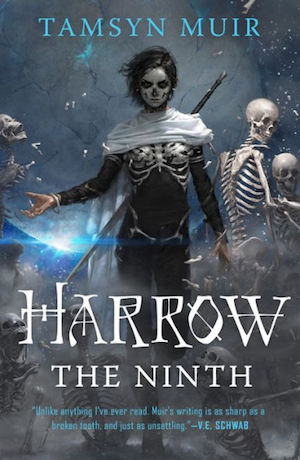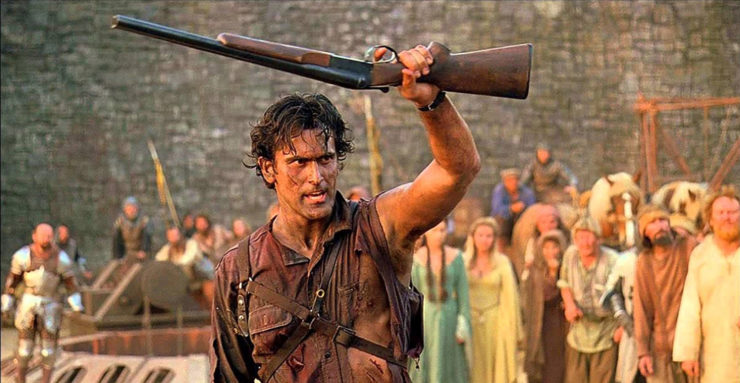“Good, bad—I’m the guy with the gun,” Ash Williams (Bruce Campbell) tells his evil doppelgänger after blowing him away in Army of Darkness. The third film in the Evil Dead series is notable for its ambivalence about evil. Part of that is because the whole movie is a goof; like The Naked Gun or Monty Python and the Holy Grail, its plot is little more than an excuse to get from one gag to another. But it’s also because director Sam Raimi and Campbell are semi-ironically, semi-genuinely fascinated with the toxic masculinity of action movie heroes.
Ash is, to put it bluntly, a jerk; there’s not much difference between him and his evil double, except that, as he says, he’s the one with the gun. As a result, it’s not exactly clear whether we’re rooting for him because he’s on the side of the angels, or simply because he’s better looking than the evil dead, and because we know he’s going to win.
Ash in Evil Dead II had much less of the anti-hero about him. He didn’t, in fact, have much of a personality at all—as the victim of an eldritch evil, he spends most of his time screaming and fighting back in a state of desperation bordering on insanity.
Army of Darkness is a different genre, though, and Ash’s role in the film is much more proactive and heroic. That’s established right at the beginning of the movie. In Evil Dead II, the opening exposition dump is narrated by a disembodied, serious, non-specific non-character. But in Army of Darkness it’s Ash himself who gives us the background about the eldritch book, the Necronomicon. He’s the one who explains how it summoned demons who possessed his girlfriend during their visit to a remote cabin, and how he was sucked into the past while fighting against it. The story is told through his eyes; he’s the hero.
Being a hero, in this context, means being an asshole. Ash, with a chainsaw where his severed hand should be, drops through a time portal with his ’73 Oldsmobile and lands in the 13th century. He is captured by a bunch of knights, and after some confusion is recognized as the chosen one who will help Lord Arthur (Marcus Gilbert) find the Necronomicon and defeat the undead.
Buy the Book


Harrow the Ninth
Along the way, he’s rude and abusive to basically everyone. When a fellow prisoner identifies himself as Duke Henry, lord and leader of the Northlands, Ash sneers at him in a bizarre fit of what sounds like envy: “You ain’t leading but two things right now: Jack and shit. And Jack left town.” He calls the medieval people “primates.” His idea of foreplay is to tell love interest Sheila (Embeth Davidtz) that “your primitive intellect wouldn’t understand alloys and compositions and things with…molecular structures.” He’s such a narcissistic gasbag that he won’t even take the time to memorize the magic words he needs in order to retrieve the Necronomicon safely. He fucks up the incantation, and so brings a plague of undead skeletons upon them all.
Ash’s awfulness is a joke; it’s an excuse for the writers to give him hyperbolic tough guy bravado dialogue like, “Yo! She-bitch! Let’s go!” But it’s also an expansion, or exploration, of the series’ themes. The Evil Dead and its remake/sequel Evil Dead II are about people being possessed by demons. Through both films, humans keep turning into nightmare monsters; in Evil Dead II, even Ash’s hand “went bad,” as his narration tells us. In a somewhat silly, hyperbolic horror movie way, the movies are about the human potential for corruption and susceptibility to evil. We’re all just monstrous deadites waiting to be born.
Army of Darkness doubles down on the evil double theme. The film’s central, brilliant set piece is a manic, Looney Tunes-esque cartoonish sequence in which Ash’s reflection comes alive in a mirror; after he breaks it, the tiny Ashes reflected in each shard climb out to attack him. They knock him out and one of the mini-Ashes leaps into his mouth. It starts growing to full height inside him, eventually splitting off from in a bizarre, grotesque mitosis. Ash shoots his evil double and buries it, but after he screws up the magic words, it rises from the dead with a rotted face and a bad attitude to lead the undead in a siege against the castle where Ash and Lord Arthur wait.
The Ash vs. Ashes scene is a triumph of loopy nightmare imagination, like something out of Kafka animated and fueled by laughing gas. Part of what makes it work so well is that the evil Ashes behave almost exactly like the original, supposedly good Ash, down to the snarky, juvenile quips. They’re all equally appealing and equally repulsive.
That joyful war of bounder against bounder reaches an uneasy apotheosis after evil Ash rises from the grave and sends a flying deadite to capture Sheila. When she is brought before him, he says, “gimme some sugar, baby…” and kisses her. She first resists, then is possessed and consents. This exactly parallels the earlier scene where Ash insults Sheila, grabs her roughly, saying “gimme some sugar, baby…”—and then kisses her in a way that implies that she consents, but may not have a whole lot of options if she didn’t.

The main difference between Ash and Evil Ash’s romantic approaches is that Evil Ash and Evil Sheila seem to have a more egalitarian relationship than their supposedly good counterparts. As a human, Sheila doesn’t get to do much but moon about and scream. As a deadite, she rides to battle as an equal and gets to try to pound the snot out of good Ash, who surely deserves it. “I may be bad, but I feel good,” Evil Sheila says with great satisfaction. She must be a little disappointed when she’s eventually “cured,” and has to go back to being a boring arm decoration who barely even gets a goodbye when the Necronomicon sends Ash back to his own time.
Ash’s assholishness could be seen as a parody of action movie assholes past. When he brandishes his shotgun and bellows “This is my boomstick!” it’s hard to miss the vaunting double entendre, especially when the next scene has him lounging on a couch as women feed him grapes and drape themselves all over him. His masculinity is so bombastically overcarbonated it’s practically a caricature. And sure enough, at the end of the movie, when Ash has returned to his own time, he’s back selling home goods at S-Mart, muttering to his coworkers about how he coulda been a king. The whole story is revealed to be a sad, perhaps delusional power fantasy—until a shopper is possessed by a deadite, and Ash swings into action, killing her before sweeping some conveniently positioned sweet young thing into his arms for a reward kiss.
Evil Dead and Evil Dead II are both exhilarating because of their creativity. They encourage you to identify with the filmmaker, first of all, and cheer at the virtuoso monstrosties he creates. Army of Darkness, for all its inventive genre scrambling, is a more conventional film, which revels less in creativity per se than in the swollen ego of a fairly standard-issue Badass Action Hero Dude. It’s still a fun romp, but it’s a little disappointing that in creating this third and final installment of the series, the idiosyncratic creative vision of Sam Raimi seems possessed by that obnoxious tough guy, Evil Ash.
Noah Berlatsky is the author of Wonder Woman: Bondage and Feminism in the Marston/Peter Comics (Rutgers University Press).










